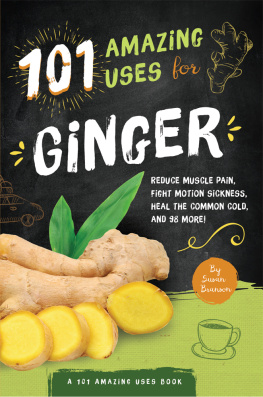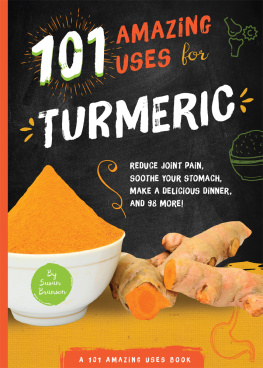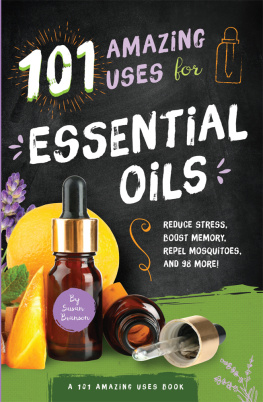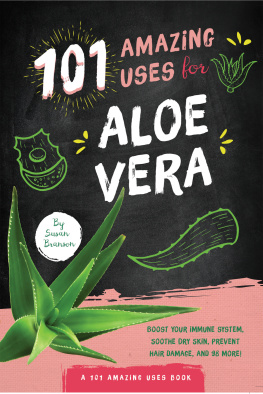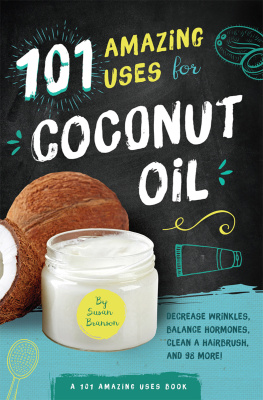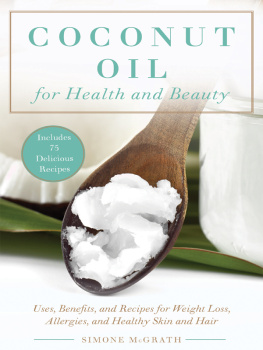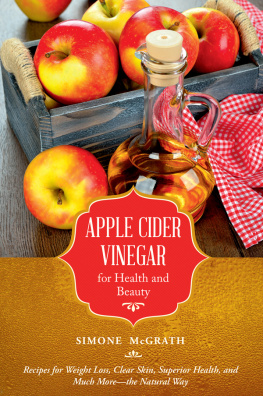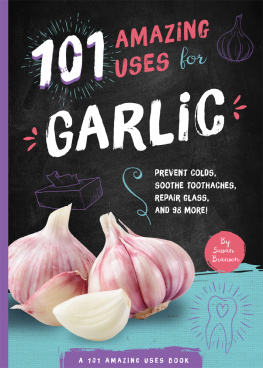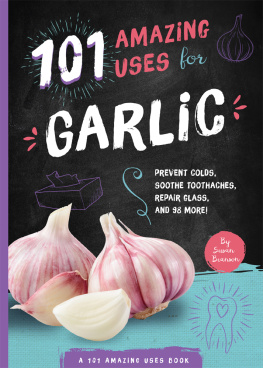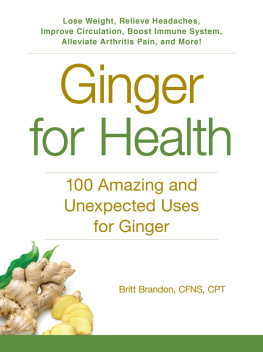Branson - 101 Amazing Uses For Ginger
Here you can read online Branson - 101 Amazing Uses For Ginger full text of the book (entire story) in english for free. Download pdf and epub, get meaning, cover and reviews about this ebook. City: New York, year: 2017, publisher: Familius LLC, genre: Home and family. Description of the work, (preface) as well as reviews are available. Best literature library LitArk.com created for fans of good reading and offers a wide selection of genres:
Romance novel
Science fiction
Adventure
Detective
Science
History
Home and family
Prose
Art
Politics
Computer
Non-fiction
Religion
Business
Children
Humor
Choose a favorite category and find really read worthwhile books. Enjoy immersion in the world of imagination, feel the emotions of the characters or learn something new for yourself, make an fascinating discovery.
- Book:101 Amazing Uses For Ginger
- Author:
- Publisher:Familius LLC
- Genre:
- Year:2017
- City:New York
- Rating:5 / 5
- Favourites:Add to favourites
- Your mark:
- 100
- 1
- 2
- 3
- 4
- 5
101 Amazing Uses For Ginger: summary, description and annotation
We offer to read an annotation, description, summary or preface (depends on what the author of the book "101 Amazing Uses For Ginger" wrote himself). If you haven't found the necessary information about the book — write in the comments, we will try to find it.
101 Amazing Uses For Ginger — read online for free the complete book (whole text) full work
Below is the text of the book, divided by pages. System saving the place of the last page read, allows you to conveniently read the book "101 Amazing Uses For Ginger" online for free, without having to search again every time where you left off. Put a bookmark, and you can go to the page where you finished reading at any time.
Font size:
Interval:
Bookmark:

TO JEFF
Copyright 2017 by Susan Branson
All rights reserved.
Published by Familius LLC, www.familius.com
Familius books are available at special discounts for bulk purchases, whether for sales promotions or for family or corporate use. For more information, contact Familius Sales at 559-876-2170 or email .
Reproduction of this book in any manner, in whole or in part,
without written permission of the publisher is prohibited.
DISCLAIMER: The material in this book is for informational purposes only. It is not intended to be a substitute for professional medical advice, diagnosis, or treatment. Always seek the advice of your physician or other qualified healthcare provider with any questions you may have regarding a medical condition or treatment. Never disregard professional medical advice or delay in seeking it because of something you have read in this book.
Library of Congress Cataloging-in-Publication Data
2017932168
Print ISBN 9781945547126
Ebook ISBN 9781945547478
Hardcover ISBN 9781945547485
Printed in the United States of America
Edited by Lindsay Sandberg
Cover design by David Miles
Book design by Brooke Jorden and David Miles
10 9 8 7 6 5 4 3 2 1
First Edition


CONTENTS

INTRODUCTiON

WHAT IS THIS KNOBBY ROoT?
Most know ginger as a yellow spice in the baking aisle of the grocery store. Its in the same family as turmeric and cardamom, other familiar spices. Bought fresh, it has beige- to brown-colored skin covering knobby, fingerlike projections. These projections are called rhizomes and are the horizontal stems of the plant that are found underground and from which both the upright stem and roots of the plant grow. Underneath the skin is the wonderfully aromatic ivory- to yellow-colored flesh. When cut into, a spicy, lemony, and pungent smell fills the air.
The ginger root shows up in stores all around the world, but it is native to the warmer climates of Asiaparticularly India and Chinaalthough Australia, Brazil, Jamaica, West Africa, and parts of the United States now cultivate it. Its a perennial, so it comes up every year. It has long, narrow green leaves and green-purple flowers that look somewhat like orchids.
Ginger is teeming with more than one hundred fifteen chemical constituents in the rhizome, with at least fourteen found to be bioactive. The main groups of bioactive compounds are called gingerols and shogaols , and the amount of each of these depends on where the ginger was grown, the commercial processor, and the form it is infresh, dried, or processed.
It is the gingerols in particular that give the ginger its pungent flavor and are thought to be responsible for most of the pharmacological actions, which is how ginger can have such a varied and significant impact on our bodies. Ginger is metabolized and readily absorbed after ingestion, meaning that ginger gets broken down into its chemical components so they can be used by our bodies for a number of benefits. It is not surprising, then, to see some of its therapeutic benefits in these areas. Among its most notable actions are its anti-inflammatory, antioxidant, antiemetic (nausea), analgesic (pain), antipyretic (fever), antitussive (cough), and antibiotic properties. This book shows how ginger can be used to treat an incredible assortment of conditions from colds to cancer and how it is effectively used in natural beauty treatments.

WHERE DID IT CoME FRoM?
Having been coveted and cultivated for as long as five thousand years, ginger has stood the test of time. Our ancestors were onto something. Originating in the beautiful jungles of Southern Asia, the people of India and China are thought to be the first to have used ginger to treat their ailments and as a flavoring agent in their food and drinks. Chinese records indicate those who grew acres of ginger enjoyed great wealth, likely using it in trade. Even Confucius was a fan, reportedly never being without it at meals.
Ginger was then brought from India to Ancient Rome over two thousand years ago by Arab traders and used extensively by the Romans for its medicinal properties until the Roman Empire fell. Pedanius Dioscorides, a Greek physician traveling throughout the Roman Empire, would collect local medicinal herbs and record his findings, notes which he later turned into De Materia Medica , a vast reference book on the medicinal properties of over a thousand herbs. He wrote that ginger is right good with meat in sauces, or otherwise in conditures: for it is of an heating and digesting quality; it gently looseth the belly, and is profitable for the stomach, and effectually opposeth itself against all darkness of the light; answering the qualities and effects of pepper. Undoubtedly, ginger was used as a digestive aid, for flavoring, and as a warming agent. The Greeks prized ginger so highly, they mixed it into their breads to create the first gingerbreads.
Unfortunately, with the fall of Rome, ginger was lost in Europe until the eleventh century. Once reintroduced, it quickly gained popularity, surpassed only by black pepper in the fourteenth century. It was so coveted that it became very expensive. One pound of ginger was the equivalent in trade to one sheep. Queen Elizabeth I of England was noted to be especially fond of preserved ginger and had it used in the making of sweets. She is credited with the invention of the gingerbread man, a cookie popular with kids today.
Toward the end of the Middle Ages and the emergence of world travel, ginger made its way to the New World with the Spanish Conquistadores. It reached the rest of the world with Western European explorers and travelers. Soon, everyone was enjoying this magnificent plant.

WHATS THE BEST WAY To BuY AND SToRE GINGER?
Fresh ginger is easy to find in the produce section of almost all grocery stores. Fresh ginger has the highest amounts of the active component gingerol and will impart superior flavor compared to other forms. Young ginger, or spring ginger, is harvested at five months and is not yet mature. The skin is thin and edible, the rhizomes tender, and the flavor mild. It will have pink tips and be lighter in color than mature ginger. Mature ginger is harvested a few months later and has a tougher skin that must be carefully peeled away before eating. The skin should still be smooth and firm with a light sheen. For a more pungent flavor, this is the way to go. Be careful not to buy too old, though. Fresh ginger loses moisture and becomes woody and stringy as it ages. Stay away from ginger that is wrinkled or moldysure indications of decay. Store your fresh ginger unpeeled in the refrigerator for up to three weeks or in the freezer for six months or longer.
Next pageFont size:
Interval:
Bookmark:
Similar books «101 Amazing Uses For Ginger»
Look at similar books to 101 Amazing Uses For Ginger. We have selected literature similar in name and meaning in the hope of providing readers with more options to find new, interesting, not yet read works.
Discussion, reviews of the book 101 Amazing Uses For Ginger and just readers' own opinions. Leave your comments, write what you think about the work, its meaning or the main characters. Specify what exactly you liked and what you didn't like, and why you think so.

